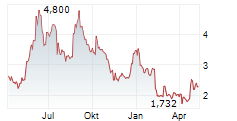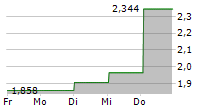
LUND, Sweden, Oct. 7, 2024 /PRNewswire/ -- Hansa Biopharma AB, ("Hansa" or the "Company") (NASDAQ STOCKHOLM: HNSA), today announced positive results from a 12-month follow up analysis from the NICE-01 trial of HNSA-5487, the Company's next generation immunoglobulin G (IgG)-cleaving molecule, assessing IgG recovery, immunogenicity and redosing potential.
In the NICE-01 trial, HNSA-5487 demonstrated rapid and highly robust reduction of IgG levels by more than 95 percent within a few hours post treatment. In a 12-month follow up analysis IgG levels returned to normal range six months after initial dosing. This confirms that HNSA-5487 mirrors the extremely high efficacy of imlifidase, the Company's first-generation IgG-cleaving enzyme, in reducing total IgG levels. No serious adverse events were observed and as previously communicated HNSA-5487 is safe and well tolerated.
Importantly, HNSA-5487 demonstrated lower pre-treatment anti-drug antibody (ADA) levels and significantly reduced ADA responses when compared to imlifidase, confirming an attractive immunogenicity profile with a clear redosing potential. HNSA-5487 also demonstrated highly robust reduction in IgG levels with similar efficacy in nearly 100 percent of serum samples collected in the trial and analyzed at six- and 12-months after the initial dose.
Søren Tulstrup, President and CEO, Hansa Biopharma said, "There is mounting clinical evidence that faster and more robust IgG reduction is directly linked to more successful therapeutic outcomes in autoimmune and other diseases. We are very encouraged by these results that demonstrate HNSA-5487 can robustly and very rapidly reduce IgG levels, has redosing potential, and a favorable safety and tolerability profile. We believe HNSA-5487 has a highly differentiated profile compared to published data from studies with other IgG-targeted therapies. These results underscore the transformational potential of HNSA-5487 to address significant unmet need across a spectrum of IgG driven diseases and conditions, including autoimmune where there is a clear need for better management of initial and repeat immune system attacks."
The Company will focus clinical development of HNSA-5487 in chronic autoimmune diseases where IgG plays a role in disease pathology and acute phases. Initial clinical development of HNSA-5487 will focus in myelin oligodendrocyte glycoprotein antibody disease (MOGAD), neuromyelitis optica (NMO) and myasthenia gravis (MG). MOGAD affects 2 - 3.4 in every 100,000 people worldwide and approximately 30 percent of all cases are in children.1 NMO affects approximately seven in every 100,000 people in the US and approximately 22,000 people in the US are living with the condition.2 Globally, approximately 150 to 200 out of every million people have MG.3
These conditions have a common underlying cause: misguided IgG antibodies. Despite the serious nature of these diseases, unmet medical need remains high with few advanced therapies available, and no treatments approved for the acute phases. HNSA-5487 can effectively and quickly reduce IgG levels, potentially addressing a diverse range of debilitating symptoms caused by these conditions.
NICE-01 is a double blind, randomized, placebo-controlled trial evaluating safety, tolerability, pharmacokinetics (PK) and pharmacodynamics (PD) of single ascending doses of HNSA-5487 administered as a single intravenous (IV) infusion. The trial included a total of 36 healthy male and female adult participants. There were no serious adverse events and as previously communicated HNSA-5487 was safe and well tolerated.
Hansa Biopharma will host a telephone conference on 7 October at 14:00 CET / 8:00 AM EST.
Slides used in the presentation will be available online following the call.
To participate in the telephone conference, please use the dial-in details provided below:
Participant Dial In (Toll Free): 1-877-270-2148
Participant International Dial In: 1-412-902-6510
*Please ask to be joined into the Hansa Biopharma call
Join the webcast here: https://event.choruscall.com/mediaframe/webcast.html?webcastid=6iGh9S4f
Contacts for more information:
Evan Ballantyne, Chief Financial Officer
IR@hansabiopharma.com
Stephanie Kenney, VP Global Corporate Affairs
media@hansabiopharma.com
Notes to editors
About HNSA-5487 and the Novel IgG Cleaving Enzyme for Repeat Dosing (NiceR) Program
HNSA-5487 is Hansa Biopharma's next-generation IgG-cleaving enzyme with the potential to prolong the IgG-low window. In 2023, Hansa conducted the first-in-human trial of HNSA-5487 (NICE-01) reporting positive high-level results on safety and tolerability and observing complete depletion of IgG antibodies at increasing doses.
NiceR is Hansa Biopharma's next generation IgG-cleaving enzyme program. It is in preclinical development and is designed to enable expansion into a large spectrum of potential indications, including relapsing autoimmune diseases and gene therapy, as well as oncology indications. The lead molecule in the NiceR program is HNSA-5487.
About imlifidase
Imlifidase is an antibody-cleaving enzyme originating from Streptococcus pyogenes that specifically targets and cleaves immunoglobulin G (IgG) antibodies and inhibits IgG-mediated immune response.4 It has a rapid onset of action, cleaving IgG-antibodies and inhibiting their activity within hours after administration.
Imlifidase has conditional marketing approval in Europe and is marketed under the trade name IDEFIRIX® for the desensitization treatment of highly sensitized adult kidney transplant patients with a positive crossmatch against an available deceased donor.
The use of IDEFIRIX should be reserved for patients who are unlikely to be transplanted under the available kidney allocation system, including prioritization programs for highly sensitized patients.4 IDEFIRIX was reviewed as part of the European Medicines Agency's (EMA) Priority Medicines (PRIME) program, which supports medicines that may offer a major therapeutic advantage over existing treatments or benefit patients without treatment options.4
The efficacy and safety of imlifidase as a pre-transplant treatment to reduce donor-specific IgG was studied in four phase 2 open-label, single-arm, six-month clinical trials.5,6,7
Hansa is collecting further clinical evidence and will submit additional efficacy and safety data based on one observational follow-up study and one post-approval efficacy study.
Full product information can be accessed via the initial Summary of Product Characteristics found here.
About Myelin Oligodendrocyte Glycoprotein Antibody Disease (MOGAD)
MOGAD is an inflammatory disorder of the central nervous system characterized by attacks of immune-mediated demyelination predominantly targeting the optic nerves, brain, and spinal cord.8 It is associated with the presence of antibodies directed against myelin oligodendrocyte glycoprotein (MOG).
MOG is found in the myelin that insulates the nerves of the central nervous system, which consists of the brain, spinal cord and optic nerves. The antibody attack on MOG?disrupts the transmission of nerve signals in the body and causes a variety of symptoms including changes in vision, weakness and numbness of the limbs, and paralysis.9
MOGAD affects 2 - 3.4 in every 100,000 people worldwide and approximately 30 percent of all cases are in children.1
About Neuromylelitis Optica (NMO)
NMO is a rare autoimmune disease of the central nervous system (CNS) that mainly affects the optic nerves and spinal cord. It is sometimes referred to as NMO spectrum disorder or NMOSD.
In NMO, the body's immune system mistakenly attacks healthy cells and proteins in the body, most often those in the spinal cord and eyes. Symptoms include eye pain and vision loss, weakness or paralysis of arms and legs, and severe vomiting and nausea. There is no cure for NMO, and relapses and attacks are often treated with corticosteroid drugs and plasma exchange.10
NMO affects approximately seven in every 100,000 people in the US. About 22,000 people in the US are living with the condition.2
About Myasthenia Gravis (MG)
MG is a rare, chronic autoimmune neuromuscular disorder that is characterized by fluctuating weakness of the voluntary muscle groups. Approximately half of all people with MG will experience weakness in the eye (ocular) muscles first, which can include double vision, blurred vision and drooping eyelids. Eight out of 10 people with MG will develop more widespread weakness including in the neck, face, arms or legs.11,12
Current immunomodulatory treatments do not achieve sufficient improvement or resolution of symptoms and more targeted therapies are needed.13
Globally, approximately 150 to 200 out of every million people have MG. In the US it is estimated that 37 out of every 100,000 people have MG.3
About Hansa Biopharma
Hansa Biopharma is a pioneering commercial-stage biopharmaceutical company on a mission to develop and commercialize innovative, lifesaving and life-altering treatments for patients with rare immunological conditions. Hansa Biopharma has developed a first-in-class immunoglobulin G (IgG) antibody-cleaving enzyme therapy, which has been shown to enable kidney transplantation in highly sensitized patients. Hansa Biopharma has a rich and expanding research and development program based on the Company's proprietary IgG-cleaving enzyme technology platform, to address serious unmet medical needs in transplantation, autoimmune diseases, gene therapy and cancer. Hansa Biopharma is based in Lund, Sweden, and has operations in Europe and the U.S. The company is listed on Nasdaq Stockholm under the ticker HNSA. Find out more at www.hansabiopharma.com and follow us on LinkedIn.
©2024 Hansa Biopharma. Hansa Biopharma, the beacon logo, and IDEFIRIX are trademarks of Hansa Biopharma AB, Lund, Sweden. All rights reserved.
References
- Hor, Jyh Yung, and Kazuo Fujihara. "Epidemiology of myelin oligodendrocyte glycoprotein antibody-associated disease: a review of prevalence and incidence worldwide." Frontiers in neurology vol. 14 1260358. 15 Sep. 2023, doi:10.3389/fneur.2023.1260358.
- Briggs FB, Shaia J. Prevalence of neuromyelitis optica spectrum disorder in the United States. Multiple Sclerosis Journal. 2024;30(3):316-324. doi:10.1177/13524585231224683
- Dresser L, Wlodarski R, Rezania K, et al. Myasthenia gravis: epidemiology, pathophysiology and clinical manifestations. J Clin Med 2021; 10: 2235.
- European Medicines Agency. Idefirix® summary of product characteristics. Available at: https://www.ema.europa.eu/en/documents/product-information/idefirix-epar-product-information_en.pdf.
- Jordan SC, et al. IgG Endopeptidase in Highly Sensitized Patients Undergoing Transplantation. N Engl J Med 2017;377:442-453. DOI: 10.1056/NEJMoa16125
- Winstedt L, et al. Complete Removal of Extracellular IgG Antibodies in a Randomized Dose-Escalation Phase I Study with the Bacterial Enzyme IdeS--A Novel Therapeutic Opportunity. PLoS One. 2015 Jul 15;10(7):e0132011. doi: 10.1371/journal.pone.0132011. PMID: 26177518; PMCID: PMC4503742.
- Jordan SC, et al. Imlifidase Desensitization in Crossmatch-positive, Highly Sensitized Kidney Transplant Recipients: Results of an International Phase 2 Trial (Highdes). Transplantation. 2021 Aug 1;105(8):1808-1817. doi: 10.1097/TP.0000000000003496
- Flanagan E, et al. Myelin oligodendrocyte glycoprotein antibody-associated disease (MOGAD): Clinical features and diagnosis. Available at https://www.uptodate.com/contents/myelin-oligodendrocyte-glycoprotein-antibody-associated-disease-mogad-clinical-features-and-diagnosisreferences . Accessed on 17 September, 2024.
- MOGAD Disorder and Multiple Sclerosis: Understanding Myelin Oligodendrocyte Glycoprotein Antibody Disease (MOGAD). National MS Society. March 2023. https://www.nationalmssociety.org/understanding-ms/what-is-ms/related-conditions/mogad. Accesses 17 September 2024.
- Neuromyletis optica (NMO). Available at https://www.ninds.nih.gov/health-information/disorders/neuromyelitis-optica. Accessed on 17 September 2024.
- Dresser L, Wlodarski R, Rezania K, et al. Myasthenia gravis: epidemiology, pathophysiology and clinical manifestations. J Clin Med 2021; 10: 2235.
- Punga A, Maddison P, Heckmann J, et al. Epidemiology, diagnostics, and biomarkers of autoimmune neuromuscular junction disorders. Lancet Neurol 2022; 21: 176-188.
- Schneider-Gold, Christiane, and Nils Erik Gilhus. "Advances and challenges in the treatment of myasthenia gravis." Therapeutic advances in neurological disorders vol. 14 17562864211065406. 21 Dec. 2021, doi:10.1177/17562864211065406
This information was brought to you by Cision http://news.cision.com
https://news.cision.com/hansa-biopharma-ab/r/hansa-biopharma-s-hnsa-5487-achieved-rapid-and-highly-robust-igg-reduction-by-more-than-95--and-clea,c4047312
The following files are available for download:
https://mb.cision.com/Main/1219/4047312/3039645.pdf | 20241007_5487 Analysis and Indication PR - eng |
![]() View original content:https://www.prnewswire.co.uk/news-releases/hansa-biopharmas-hnsa-5487-achieved-rapid-and-highly-robust-igg-reduction-by-more-than-95-and-clear-redosing-potential-in-first-in-human-trial-302268672.html
View original content:https://www.prnewswire.co.uk/news-releases/hansa-biopharmas-hnsa-5487-achieved-rapid-and-highly-robust-igg-reduction-by-more-than-95-and-clear-redosing-potential-in-first-in-human-trial-302268672.html




